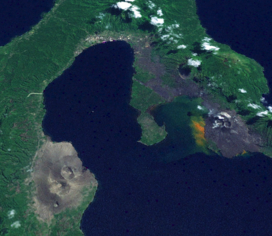
Back Rabaul (sopka) Czech Volcán Rabaul Spanish Rabaul (volcan) French קלדרת רבאול HE Kaldera Rabaul ID Rabaul (vulcano) Italian 라바울 칼데라 Korean Rabaul (vulkaan) Dutch Rabaul (volcan) Occitan Рабаул (кальдера) Russian
| Rabaul caldera | |
|---|---|
 True-colour image of the Rabaul caldera from space. From left to right: Vulcan (twin cones), Rabalanakaia, Tavurvur. | |
| Highest point | |
| Elevation | 688 m (2,257 ft)[1] |
| Listing | List of volcanoes in Papua New Guinea |
| Coordinates | 4°16′16″S 152°12′11″E / 4.27111°S 152.20306°E[1] |
| Geography | |
| Geology | |
| Rock age | ~1,400 years |
| Mountain type | Pyroclastic shield/Caldera |
| Volcanic arc | Bismarck volcanic arc |
| Last eruption | August to September 2014 [1] |
The Rabaul caldera, or Rabaul Volcano, is a large volcano on the tip of the Gazelle Peninsula in East New Britain, Papua New Guinea, and derives its name from the town of Rabaul inside the caldera. The caldera has many sub-vents, Tavurvur being the most well known for its devastating eruptions over Rabaul. The outer flanks of the highest peak, a 688-metre-high asymmetrical pyroclastic shield, are formed by thick pyroclastic flow deposits.[1] There is no sign of a pyroclastic shield along the rim of the caldera, making the location likely underwater, on the caldera's floor.
Tavurvur, a stratovolcano and a sub-vent of the caldera, is the most visibly active, continuously throwing ash. In 1994 it, and nearby Vulcan, erupted and devastated Rabaul; however, due to planning for such a catastrophe, the townsfolk were prepared and only five people were killed. One of the deaths was caused by lightning, a feature of volcanic ash clouds.[2][3][4]
In 1937, Vulcan and Tavurvur erupted simultaneously, killing 507 people. This event led to the founding of the Rabaul Volcano Observatory, which watches over the many active volcanoes in Papua New Guinea.[5] One eruption over several days in March 2008 released a plume of ash and water vapor that drifted northwest over the Bismarck Sea.[6]
- ^ a b c d "Rabaul". Global Volcanism Program. Smithsonian Institution. Retrieved 2020-03-26.
- ^ Simons, Paul (May 8, 2008). "Dirty thunderstorm shoots lightning from volcano". London: Times Online. Archived from the original on May 17, 2008. Retrieved 2009-01-09.
- ^ Perkins, Sid (March 4, 2015). "Flash glass: Lightning inside volcanic ash plumes create glassy spherules". American Association for the Advancement of Science.
- ^ Sample, Ian (3 December 2015). "Sky lights up over Sicily as Mount Etna's Voragine crater erupts". the Guardian. Retrieved 2015-12-03.
- ^ Smithsonian Institution / SEAN (1989). Lindsay McClelland; Tom Simkin; Marjorie Summers; Elizabeth Nielsen; Thomas C. Stein (eds.). Global Volcanism 1975–1985. Prentice Hall, Englewood Cliffs NJ, and American Geophysical Union, Washington DC. pp. 180–189. ISBN 0-13-357203-X.
- ^ "Rabaul Volcano, New Britain". NASA Earth Observatory. Archived from the original on 28 March 2008. Retrieved 20 March 2008.
